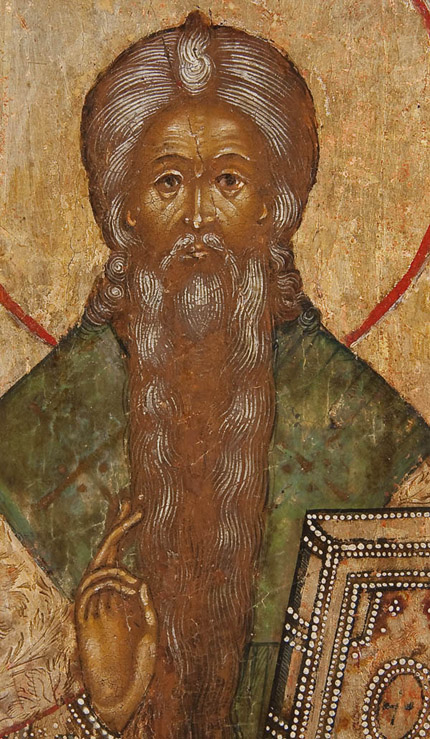Another multiple icon:

Photographing such heavily gold-leafed icons can often be tricky, particularly when an icon has warped a bit into a convex shape, as is common with so very many old icons.
In any case, if you are a long-time reader of my site, you should be able to easily identify all the icon types included.
At upper left is the “Lord Almighty” type — Jesus holding the open Gospels:
The text from Matthew 11:28 reads:
Приидите ко Мне вси труждающиися и обремененнии, и Аз упокою вы: возмите иго Мое [на себе и научитеся от Мене …]
Priidite ko mnye vsi truzhdaiushchiisya i obremyenennii, i Az upokoiu vui: Vozmite igo moe [na sebe i nauchitesya ot mene …]
“Come to me, all you who labor and are heavy laden, and I will give you rest. Take my yoke [upon you and learn from me …”]
Jesus holds his right hand in the Old Believer sign of blessing, so we know this is an Old Believer icon.
At lower left is — as the inscription says — the “‘Kazan’ Most Holy Mother of God.”
The Kazanskaya/”of Kazan” icon was discussed in this previous posting.
I hope you recall that it is one of the most common of Russian Marian icon types:
At upper right is a Bogoliubskaya icon of Mary — but we must be more specific about this type. When we see a gathering of saints to her right, it is the “Moscow Bogoliubskaya” (BogoliubskayaMoskovskaya) type. Jesus blesses from the clouds above:
The nature of the photo does not permit reading the name inscriptions on the saints (that gold leaf photography problem again), but you will find a general description of the “Moscow Bogoliubskaya” type here:
At lower right is a very pleasantly stylized image of the popular saint “Holy Priest-martyr Kharlampiy”/Kharalampos:
Like Jesus in this icon, Kharlampiy blesses with the Old Believer finger position. You will find a description of him here:
And finally, we have the central Crucifixion:
At left are “Righteous Mary,” “Righteous Martha, and the “Mother of God” — that is, Mary, the Mother of Jesus. At right are John the Theologian (the Apostle John) and the Centurion Longinos/Longinus.
You will find all the descriptions necessary to identify the Crucifixion type and its inscriptions here:
As you can see, the sun is depicted as dark, and the moon red as blood, in keeping with these biblical excerpts:
Joel 2:31:
“The sun shall be turned into darkness, and the moon into blood, before the great and terrible day of the Lord come.”
“The sun and the moon shall be darkened, and the stars shall withdraw their shining.”
The whole icon is very delightfully stylized. Note how clouds are painted as a collection of curling “snail” shapes.


